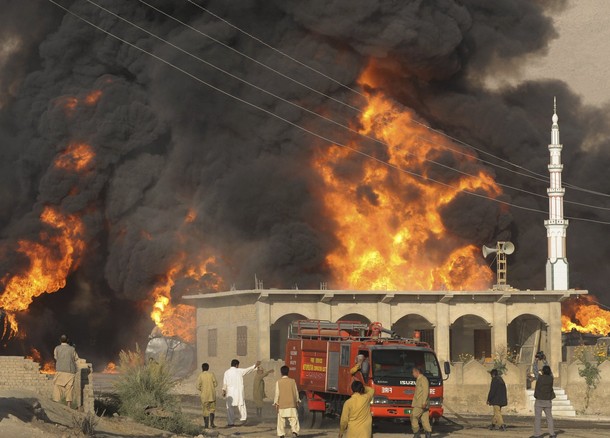
Just when it seemed that things could not get worse, they do. One would have thought that given the ongoing catastrophic floods, conditions in Pakistan were at a nadir. But last week, several incidents lowered even that bar regarding U.S.-Pakistani ties.
NATO forces in Afghanistan made two unauthorized incursions into Pakistan, the second killing three Frontier Corps soldiers. CIA drone strikes soared possibly provoked last week by threats of al-Qaida attacks in Europe using operatives trained in Pakistan carrying U.S. and friendly passports.
In response to these incidents, Pakistan closed one of the major supply routes from Karachi to Afghanistan citing “security” concerns arising from a backlash to the NATO forays into Pakistan territory.
However, the signal was unmistakable regardless of the rationale — violate our territory again and suffer the consequences.
But the potentially most damaging incident was a cellphone camera video showing Pakistani army soldiers summarily executing a handful of prisoners in their custody. The most careful investigation as to determine the real identity of the executioners is essential because the impact could be powerful in shaping even greater negative public opinion in Pakistan and in the United States.
Without a transparent, credible inquiry, hearings by the U.S. Congress into allegations of extrajudicial executions and illegal detentions by Pakistan security forces will be inevitable. The U.S. Senate had deferred these investigations including charges that the army held hundreds, if not thousands, of prisoners suspected of terrorism refusing to turn them over to the courts on the grounds that these suspects would be released and would return to the battlefield.
Ironically, America’s categorization of prisoners captured in the war on terror as “enemy combatants” and incarcerating them at Guantanamo Bay to circumvent trials in civilian U.S. courts suggests this dilemma of dealing with terrorist suspects isn’t limited to Pakistan.
And, unfortunately, Pakistan’s interior minister asking whether Americans were “friends or enemies” in light of the incursions and other incidents isn’t an idle question in either Pakistan or the United States, reflecting the growing strain.
Both Pakistan and the United States tried to reduce the impact of these events. A joint investigation of the NATO incursions and an apology by International Security Assistance Force commander U.S. Army Gen. David Petraeus to Pakistani Army Chief of Staff Gen. Ashfaq Pervez Kayani will help. However, inherent difficulties and tensions in the overall relationship have never been fully resolved and have been exacerbated possibly to the breaking point this past week.
The crucial divergences and competing interests between America and Pakistan are no secret. If Bob Woodward’s newest book “Obama’s War” is accurate, the White House regards Pakistan as “the cancer” that must be cured and on which success or failure in Afghanistan rests.
Americans rightly won’t tolerate sanctuaries in Pakistan from which Taliban fighters can rest, recuperate and return to Afghanistan to kill and maim American, NATO and Afghan forces. These sanctuaries and Pakistani reluctance to take on terrorist groups such as the Haqqani network remain major bones of contention.
Pakistan sees any encroachment on national sovereignty as intolerable. Further, given strong public antipathy to the United States (as opposed to individual Americans), any presence of U.S. forces in Pakistan is politically risky and must be limited.
Given conspiracy theories that abound, distortions and exaggerations of American military and CIA presence in Pakistan are taken as ground truth and used to whip up negative public sentiment.
Because of the historical record, many Pakistanis doubt America’s staying power in Afghanistan and resent its fickleness in using and then abandoning Pakistan at key junctures. The consequence is that Pakistan would be justified in its long-term planning “going it alone” given the hollowness of some of Washington’s prior reassurances. The effect is to widen the growing “trust deficit” between the two allies.
Opportunities must be seized from these worsening conditions. Here are two.
First, the forthcoming strategic dialogue in Washington this month can be the forum for addressing these key issues that divide and unite us. However, the two sides must agree to be candid, forthcoming and willing to compromise based on better mutual understanding of the other. That will require presidential leadership on both sides to repair the relationship.
Second, Pakistan must determine who was responsible for the summary executions and take appropriate action. If the army wasn’t responsible, that must be shown beyond a reasonable doubt. If guilt is established, either a court-martial or civil trial is essential. That happened in 1992 when the then army chief took strong action in similar circumstances.
But make no mistake: the U.S.-Pakistani relationship is suffering. The worst outcome is for that relationship to be over, over there. Both sides must understand how severely tested this relationship has become and that without bold action by Washington and Islamabad, it may not be repaired.
Harlan Ullman is Senior Advisor at the Atlantic Council, Chairman of the Killowen Group that advises leaders of government and business, and a frequent advisor to NATO. This article was syndicated by UPI. Photo credit: Reuters Pictures.
Image: 610x_33.jpg
